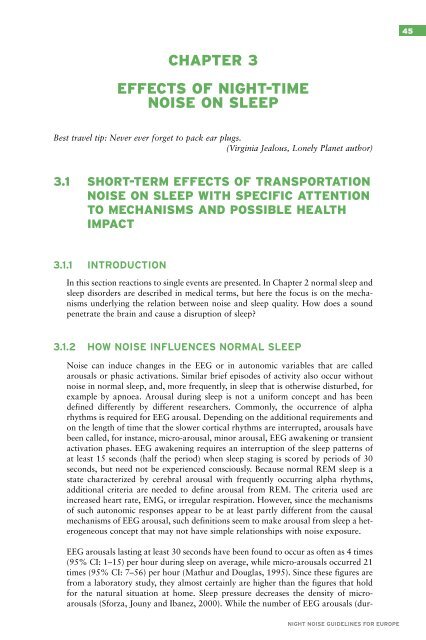Night noise guidelines for Europe - WHO/Europe - World Health ...
Night noise guidelines for Europe - WHO/Europe - World Health ...
Night noise guidelines for Europe - WHO/Europe - World Health ...
Create successful ePaper yourself
Turn your PDF publications into a flip-book with our unique Google optimized e-Paper software.
45<br />
CHAPTER 3<br />
EFFECTS OF NIGHT-TIME<br />
NOISE ON SLEEP<br />
Best travel tip: Never ever <strong>for</strong>get to pack ear plugs.<br />
(Virginia Jealous, Lonely Planet author)<br />
3.1 SHORT-TERM EFFECTS OF TRANSPORTATION<br />
NOISE ON SLEEP WITH SPECIFIC ATTENTION<br />
TO MECHANISMS AND POSSIBLE HEALTH<br />
IMPACT<br />
3.1.1 INTRODUCTION<br />
In this section reactions to single events are presented. In Chapter 2 normal sleep and<br />
sleep disorders are described in medical terms, but here the focus is on the mechanisms<br />
underlying the relation between <strong>noise</strong> and sleep quality. How does a sound<br />
penetrate the brain and cause a disruption of sleep?<br />
3.1.2 HOW NOISE INFLUENCES NORMAL SLEEP<br />
Noise can induce changes in the EEG or in autonomic variables that are called<br />
arousals or phasic activations. Similar brief episodes of activity also occur without<br />
<strong>noise</strong> in normal sleep, and, more frequently, in sleep that is otherwise disturbed, <strong>for</strong><br />
example by apnoea. Arousal during sleep is not a uni<strong>for</strong>m concept and has been<br />
defined differently by different researchers. Commonly, the occurrence of alpha<br />
rhythms is required <strong>for</strong> EEG arousal. Depending on the additional requirements and<br />
on the length of time that the slower cortical rhythms are interrupted, arousals have<br />
been called, <strong>for</strong> instance, micro-arousal, minor arousal, EEG awakening or transient<br />
activation phases. EEG awakening requires an interruption of the sleep patterns of<br />
at least 15 seconds (half the period) when sleep staging is scored by periods of 30<br />
seconds, but need not be experienced consciously. Because normal REM sleep is a<br />
state characterized by cerebral arousal with frequently occurring alpha rhythms,<br />
additional criteria are needed to define arousal from REM. The criteria used are<br />
increased heart rate, EMG, or irregular respiration. However, since the mechanisms<br />
of such autonomic responses appear to be at least partly different from the causal<br />
mechanisms of EEG arousal, such definitions seem to make arousal from sleep a heterogeneous<br />
concept that may not have simple relationships with <strong>noise</strong> exposure.<br />
EEG arousals lasting at least 30 seconds have been found to occur as often as 4 times<br />
(95% CI: 1–15) per hour during sleep on average, while micro-arousals occurred 21<br />
times (95% CI: 7–56) per hour (Mathur and Douglas, 1995). Since these figures are<br />
from a laboratory study, they almost certainly are higher than the figures that hold<br />
<strong>for</strong> the natural situation at home. Sleep pressure decreases the density of microarousals<br />
(S<strong>for</strong>za, Jouny and Ibanez, 2000). While the number of EEG arousals (dur-<br />
NIGHT NOISE GUIDELINES FOR EUROPE

















